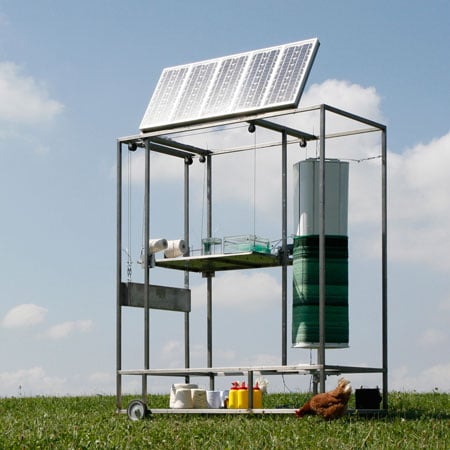DMY Berlin 09: Viennese designers Mischer'Traxler have created a solar-powered machine that makes furniture, with the shape and colour of each product determined by the amount of sunlight available during manufacture.
The machine, called The Idea of a Tree, makes benches, containers and lamp shades by drawing thread through a tank of dye followed by a tank of resin, then wrapping it around a mould that's rotated by a solar-powered machine.
The project is on show this week at DMY Youngsters exhibition in Berlin.
The speed at which the machine spins the mould and draws the thread is dictated by the amount of sunlight falling on it; the portion of a component made during a cloudy period will be darker and thinner than that made in bright sunshine.
Each piece takes one whole day to make and the resulting variations in thickness and colour-saturation along its length record the variations in daylight and shadow falling on it throughout the day.
The machine automatically starts at sunrise and stops at sunset; an item made in the winter will be shorter than one made in summer.
The finished components are made into lamps, benches and containers and stamped with the date and location where they were made.
Here's some more information from the designers:
--
The idea of a tree
This concept was inspired by a certain fascination for machines and nature. A tree is a product of its specific time and place. It reacts and develops according to its surrounding and constantly records various environmental impacts in its growth process. Each single tree tells its own story of development.
The goal of 'the idea of a tree'- project was to bring the recording qualities of a tree and its dependence on natural cycles into products.
“The idea of a tree” is an autonomous production process which combines natural input with a mechanical process. It is driven by solar energy and translates the intensity of the sun through a mechanical apparatus into one object a day.
The outcome reflects the various sunshine conditions that occur during this day. Like a tree the object becomes a three dimensional recording of its process and time of creation.
The machine starts producing when the sun rises and stops when the sun settles down. After sunset, the finished object can be ‘harvested’.
It slowly grows the object, by pulling threads through a colouring device, a glue basin and finally winding them around a mould. The length/height of the resulting object depends on the sunhours of the day. The thickness of the layer and the colour is depending on the amount of sun-energy. (more sun = thicker layer and paler colour; less sun=thinner layer and darker colour)
This correlation between input and output makes the changes visual and readable. The product becomes a three-dimensional ‘photograph’ of the time and the space where it is produced and communicates certain characteristics of locality. The process is not just reacting on different weather situations, but also on shadows happening in the machine’s direct surrounding.
Each object represents one day at one spot where it was produced. The concept of introducing natural input into a serial production process suggests a new way of looking at locality. What I would like to call industrialized locality, is not so much about local culture, craftsmanship or resources, instead it deals with the climatic and environmental factors of the process surrounding.
Various shapes and various colours are possible.

